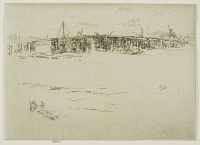KEYWORD
barge, bridge, people, derricks, river, rowing boat, steamboat.
TITLE
Examples of variations in the title are as follows:
'
Old Battersea Bridge No. 2' (1887/1888, Whistler).
2
Possibly '
Old Battersea No. 3' (1887, Whistler).
3
'
Sketch of Battersea Bridge' (1899,
Frederick Wedmore (1844-1921)).
4
'
Battersea Bridge No 2' (1903/1935, possibly
Rosalind Birnie Philip (1873-1958)).
5
'
Battersea Bridge. No. 3' (1909,
Howard Mansfield (1849-1938)).
6
There are several etchings of old Battersea Bridge and it appears that neither Whistler nor his cataloguers were always sure when to add numbers, or what numbers, in order to distinguish them. However, based on Whistler's original title, '
Old Battersea Bridge, No. 2' is satisfactory, distinguishing it from
Old Battersea Bridge
[188].
2: List, [August 1887/1888], GUW #13233.
3: Whistler to T. McLean, 21 December 1887, GUW #13017.
4:
Wedmore 1899
(cat. no. 225).
5: Envelope containing copper plate, Hunterian Art Gallery.
6:
Mansfield 1909
(cat. no. 305).
DESCRIPTION
A timbered bridge stretches across the Thames, under a cloudy sky. On it there are derricks and cranes. A river steamboat is just about to go through the central arch. Behind it, in the distance at right, are the tall chimneys and clock tower of a factory, and other buildings and warehouses on the banks are seen in the distance. At lower left is a beached rowboat, with several figures standing around the prow, on the foreshore.
SITE
Battersea Bridge crossed the river Thames in London, between Chelsea and Battersea. The clock-tower and chimneys of the Morgan Crucible Company are visible at far right, behind the bridge. The view was drawn on site and is reversed, as usual, in the etchingas printed.
The old timber bridge dated back to 1771-1772, and was built by John Philips under the direction of Henry Holland. In 1879 it was described in the Times as 'one of the old-fashioned timber structures, which will before long have to be removed and a new bridge built in its place.' 7
7: 'Freeing the Bridges', The Times, London, 24 May 1879, p. 12.
The old bridge was closed to traffic in 1883 and demolished in 1890. Sir Joseph Bazalgette's bridge was built to replace it, between 1886 and 1890.
Whistler was living near Battersea Bridge but had no direct view of it from his own house or studio. By the time he made this etching - Old Battersea Bridge, No. 2 - he was living at the Vale in Chelsea; in 1888 he stayed briefly at 14 Upper Cheyne Row before moving to the Tower House, Tite Street.
Frederick Wedmore (1844-1921) described Whistler's etching as 'A jotting of the old wooden bridge - it might almost be in process of demolition - high up in the plate.'
8 Wedmore was quite right, for the cranes and derricks were in place to help demolition.
DISCUSSION
This is one of several etchings depicting the the bridge over the Thames at Battersea, including
Under Old Battersea Bridge
[168] and
Old Battersea Bridge
[188]. This appears to be Whistler's last etching of the bridge, a record of it shortly before demolition was completed.
Between 1859 and 1879 Whistler portrayed the old bridge in drawings, etchings, lithographs, lithotints, paintings, as well as on a screen and on the wall of his house in Chelsea. His earliest painting depicting the whole bridge is Brown and Silver: Old Battersea Bridge
[y033]. In the 1870s, his studies were drawn either from a boat or the shore near Whistler's house on Lindsey Row in Chelsea.
The whole bridge is seen, rather fuzzily, in the lithograph Old Battersea Bridge, No. 2
[c013] (reproduced above), which has a roughly similar composition to the etching under discussion, Old Battersea Bridge, No. 2. Finally the bridge dominates another lithograph, Old Battersea Bridge
[c018], which was drawn from a boat at high tide, when the water conceals much of the piers.
Single piles supporting a section of bridge (making a T-shaped composition) appear in several drawings, The new Albert Bridge, seen through old Battersea Bridge
[m0480], A span of old Battersea Bridge
[m0481], Old Battersea Bridge
[m0482] and Nocturne: Battersea Bridge
[m0485], and relate to Blue and Silver: Screen, with Old Battersea Bridge
[y139]. The most famous of these compositions is the oil painting, Nocturne: Blue and Gold - Old Battersea Bridge
[y140], which reflects the strong influence of japanese prints. In addition there are two chalk drawings, Old Battersea Bridge
[m0700] and The Tall Bridge
[m0701], dating from 1878, which are studies for two lithographs, The Broad Bridge
[c011] and The Tall Bridge
[c012].

